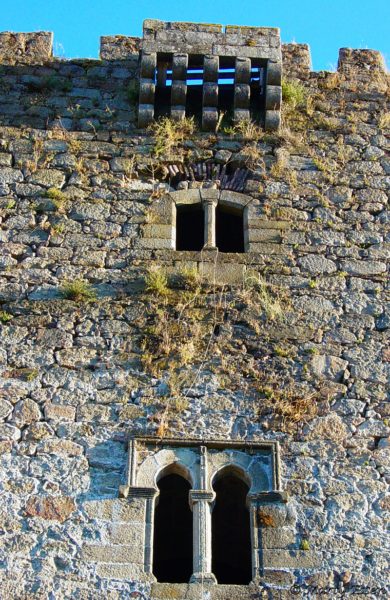
Marty’s photo of the day #2667: This is the Castle of the Sad Countess, in Spain. Now that Time Is Irreverent 2: Jesus Christ, Not Again! is at my editors, I’m already thinking about having Marty Mann and Nellie Dixon go back to 1461 to visit this castle in Time Is Irreverent 3. In the meantime, here’s some nonfiction information about the castle from my first book, Cool Creatures, Hot Planet: Exploring the Seven Continents:
Since the castle was dark inside, and many of the window openings were partially shrouded by vines, it had a haunted appearance. And who knows? Perhaps it was haunted. Its history includes multiple sackings, and its grounds were once used as a graveyard (the corpses have been relocated).
The mysterious Castle of the Sad Countess isn’t famous, but perhaps it should be, as it was once owned by a woman who was gutsy enough to stand up to the Crown, and a man whose matchmaking efforts would ultimately affect both your life and mine:
Constable Ruy López Dávalos commenced building the castle in 1393, finished it in 1423, and was kicked out one year later when King Juan II stripped him of his rank and possessions. The castle then became property of the Count of Benavente, who gave it to Don Álvaro de Luna in 1430 as a dowry for marriage to his daughter, Doña Juana de Pimentel.
Don Álvaro de Luna was King Juan II’s closest friend and second in command. During their long relationship, de Luna ran the government for the king (who was more interested in books and the arts than ruling) and on multiple occasions boldly risked his life to save the king.
After Juan II’s first wife died, de Luna arranged for the king to marry Princess Isabella of Portugal. The new queen soon became jealous of de Luna’s power and conspired against him. In 1453, three years after the royal wedding, Isabella successfully convinced the king to order the public beheading of de Luna.
Distraught over her husband’s execution, Doña Juana de Pimentel began calling herself “the Sad Countess” and signed all documents as such. One year later, King Juan II died of remorse for what he had done to his loyal friend.
Following de Luna’s death, the Sad Countess fought to prevent the Crown from repossessing her late husband’s assets. In 1461, Juan II’s son, King Enrique IV, grew tired of her resistance and sentenced her to death. Fortunately for the Countess, influential citizens interceded on her behalf and convinced Enrique to rescind his order. Although the Sad Countess lost much of her wealth, she retained her castle and lived there until shortly before her death in 1488.
How did de Luna’s matchmaking affect you and me? When King Enrique IV died, Queen Isabella I, the daughter of Isabella and Juan II, ascended to the throne. Queen Isabella I and her husband/cousin, King Ferdinand V, were the initiators of the Spanish Inquisition and the sponsors of Christopher Columbus’s historical voyage to America.